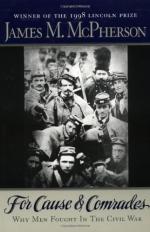
|
| Name: _________________________ | Period: ___________________ |
This test consists of 5 multiple choice questions, 5 short answer questions, and 10 short essay questions.
Multiple Choice Questions
1. Which of the following Generals retrieved his character during the Battle of Fair Oaks?
(a) General Lewis Armistead.
(b) General James Thomas.
(c) General Willis Gorman.
(d) General Mercer Tomlinson.
2. As the book opens, McPherson says that he took some Princeton students to Gettysburg in the spring of what year?
(a) 1976.
(b) 1993.
(c) 1984.
(d) 1962.
3. From which state was the soldier who felt that religion was what made brave soldiers, during the discussion of Civil War faith?
(a) Ohio.
(b) Pennsylvania.
(c) Maryland.
(d) Massachusetts.
4. In the discussion of hyped-up battle behavior, McPherson notes that the phenomenon has been described as all BUT WHICH of the following?
(a) Battle rage.
(b) Fighting madness.
(c) Military craze.
(d) Combat frenzy.
5. During his visit to the four Civil War battlefields near Fredericksburg, McPherson thinks about the fighting that happened on May 12, 1864; for how many hours did the battle last?
(a) 9.
(b) 27.
(c) 18.
(d) 4.
Short Answer Questions
1. In the discussion of the battle energy, an anemic Yale graduate--who later died at 26--recounted that the double-quick was not a fast enough pace; what disease did the man have?
2. In "Chapter 5: Religion is What Makes Brave Soldiers," a man from which state wrote he didn't feel he had any right to ask God for exemption from harm?
3. After the battle of Fredericksburg, the 10th New York had fought six battles in as many months and had lost all but how many men?
4. After the battle of Chancellorville, a lieutenant in the 17th Connecticut wrote home that the captain had resigned and gone home; what was the captain's name?
5. When discussing various war memoirs, McPherson mentions that John Haley of Maine wrote which of the following?
Short Essay Questions
1. In "Chapter 6: A Band of Brothers," what three synonyms did Civil War soldiers write a great deal about?
2. How did Civil War soldiers react to fear in "Chapter 3: Anxious for the Fray"?
3. What effect did the prospect of death have on the Confederate army during the discussion of religion?
4. How did the Civil War transform irresponsible men into responsible ones as the war got underway?
5. How did Civil War enlisted men respond to military discipline, as discussed in "Chapter 4: If I Flinched, I was Ruined"?
6. In the discussion of leadership, what qualities does McPherson say made a good officer?
7. In the discussion of leadership, what do the soldiers' letters indicate about the differences in leadership between the Confederate and Union armies?
8. In "Chapter 1: This War is a Crusade," what difference does McPherson note between the Civil War and the Vietnam War?
9. During "Chapter 3: Anxious for the Fray," what attitude did the soldiers on both sides have about the upcoming war?
10. How did the tone of soldiers' letters home change from their initial zeal after the first few battles were over?
|
This section contains 1,175 words (approx. 4 pages at 300 words per page) |

|




